2007 DODGE CARAVAN ECU
[x] Cancel search: ECUPage 44 of 520
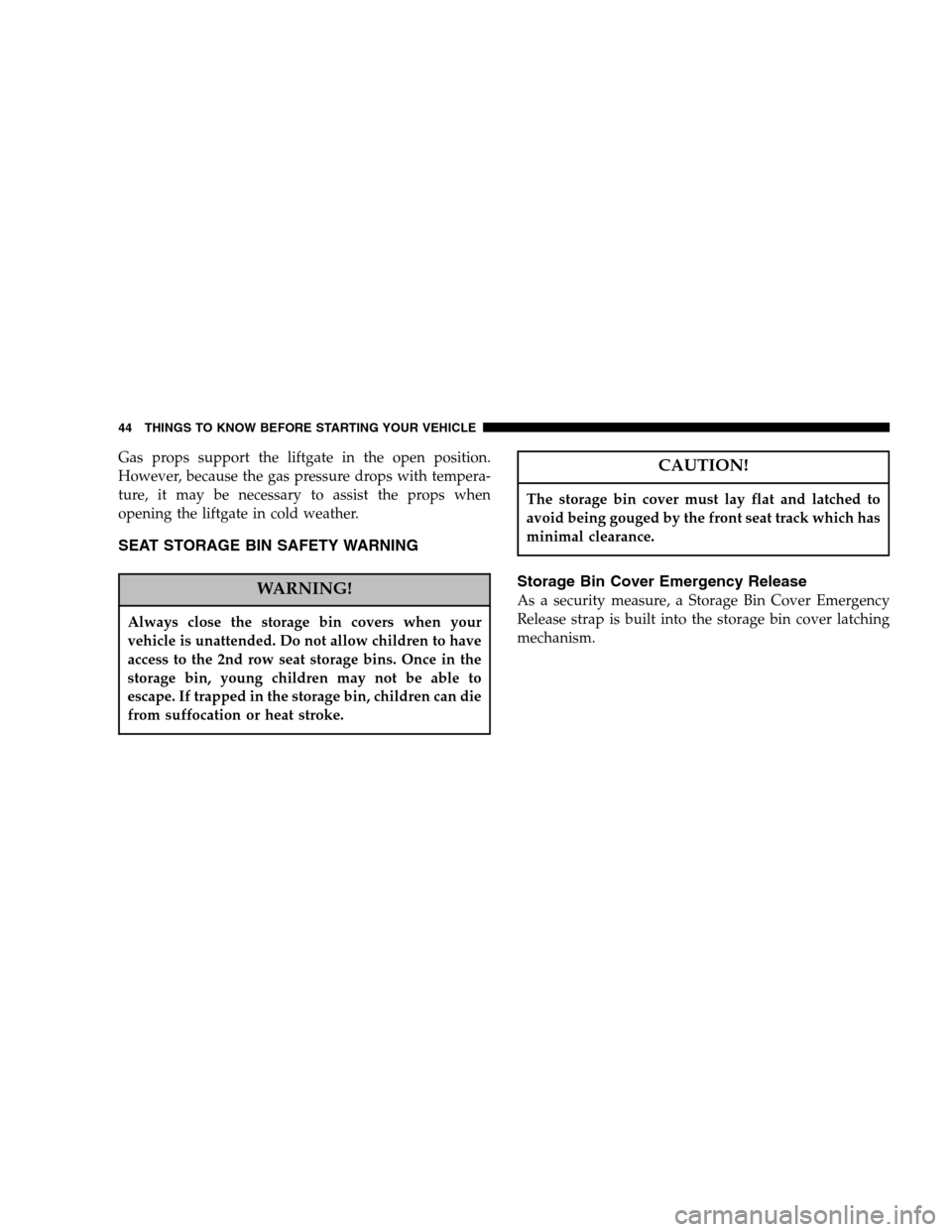
Gas props support the liftgate in the open position.
However, because the gas pressure drops with tempera-
ture, it may be necessary to assist the props when
opening the liftgate in cold weather.
SEAT STORAGE BIN SAFETY WARNING
WARNING!
Always close the storage bin covers when your
vehicle is unattended. Do not allow children to have
access to the 2nd row seat storage bins. Once in the
storage bin, young children may not be able to
escape. If trapped in the storage bin, children can die
from suffocation or heat stroke.
CAUTION!
The storage bin cover must lay flat and latched to
avoid being gouged by the front seat track which has
minimal clearance.
Storage Bin Cover Emergency Release
As a security measure, a Storage Bin Cover Emergency
Release strap is built into the storage bin cover latching
mechanism.
44 THINGS TO KNOW BEFORE STARTING YOUR VEHICLE
Page 60 of 520

NOTE:The passenger front airbag may not deploy even
when the driver front airbag has if the Occupant Classi-
fication System (refer to “Occupant Classification Sys-
tem” in this section) has determined the seat is empty or
is occupied by a child.
If your vehicle is equipped, the window bag on the crash
side of the vehicle is triggered in moderate to severe side
collisions. But even in collisions where the airbags inflate,
you need the seat belts to keep you in the right position
for the airbags to protect you properly.
Here are some simple steps you can take to minimize the
risk of harm from a deploying airbag.
1. Children 12 years old and under should always ride
buckled up in a rear seat. Infants in rear facing child restraints should
NEVERride
in the front seat of a vehicle with a passenger front airbag.
An airbag deployment can cause severe injury or death to
infants in that position.
Children that are not big enough to properly wear the
vehicle seat belt (refer to section on Child Restraint)
should be secured in the rear seat, in a child restraint or
belt-positioning booster seat. Older children who do not
use child restraints or belt-positioning booster seats
should ride properly buckled up in the rear seat, and in
the outboard seat if possible. Never allow children to
slide the shoulder belt behind them or under their arm.
If a child from 1 to 12 years old must ride in the front
passenger seat because the vehicle is crowded, move the
seat as far back as possible, and use the proper child
restraint. See the section on Child Restraint.
60 THINGS TO KNOW BEFORE STARTING YOUR VEHICLE
Page 75 of 520
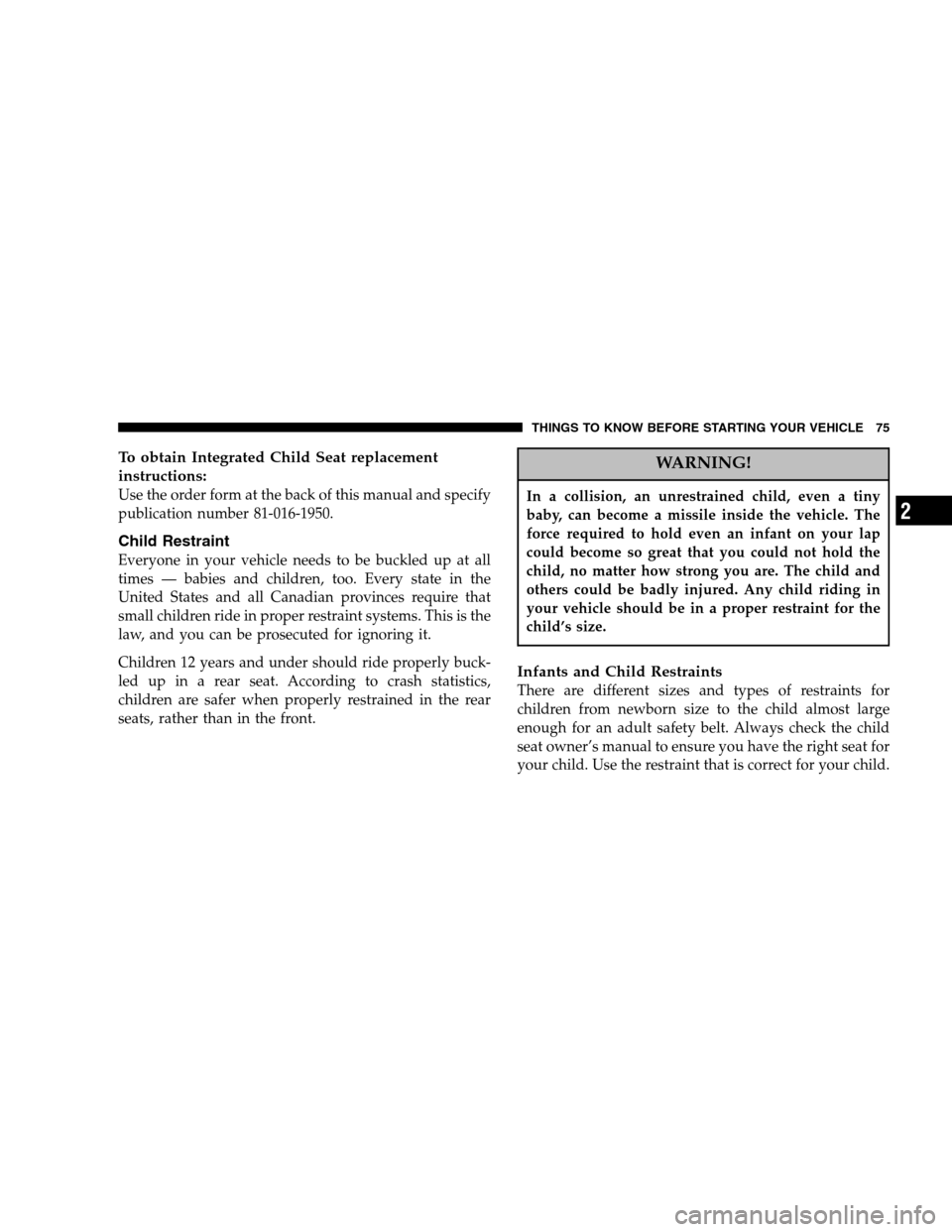
To obtain Integrated Child Seat replacement
instructions:
Use the order form at the back of this manual and specify
publication number 81-016-1950.
Child Restraint
Everyone in your vehicle needs to be buckled up at all
times — babies and children, too. Every state in the
United States and all Canadian provinces require that
small children ride in proper restraint systems. This is the
law, and you can be prosecuted for ignoring it.
Children 12 years and under should ride properly buck-
led up in a rear seat. According to crash statistics,
children are safer when properly restrained in the rear
seats, rather than in the front.
WARNING!
In a collision, an unrestrained child, even a tiny
baby, can become a missile inside the vehicle. The
force required to hold even an infant on your lap
could become so great that you could not hold the
child, no matter how strong you are. The child and
others could be badly injured. Any child riding in
your vehicle should be in a proper restraint for the
child’s size.
Infants and Child Restraints
There are different sizes and types of restraints for
children from newborn size to the child almost large
enough for an adult safety belt. Always check the child
seat owner’s manual to ensure you have the right seat for
your child. Use the restraint that is correct for your child.
THINGS TO KNOW BEFORE STARTING YOUR VEHICLE 75
2
Page 78 of 520

Here are some tips on getting the most out of your child
restraint:
•Before buying any restraint system, make sure that it
has a label certifying that it meets all applicable Safety
Standards. We also recommend that you make sure
that you can install the child restraint in the vehicle
where you will use it, before you buy it.
•The restraint must be appropriate for your child’s
weight and height. Check the label on the restraint for
weight and height limits.
•Carefully follow the instructions that come with the
restraint. If you install the restraint improperly, it may
not work when you need it.
The passenger seat belts are equipped with cinching
latch plates, which are designed to keep the lap
portion tight around the child restraint so that it is not
necessary to use a locking clip. Pulling up on the shoulder portion of the lap/shoulder belt will tighten
the belt. The cinching latch plate will keep the belt
tight, however, any seat belt system will loosen with
time, so check the belt occasionally and pull it tight if
necessary.
•In the rear seat, you may have trouble tightening the
lap/shoulder belt on the child restraint because the
buckle or latch plate is too close to the belt path
opening on the restraint. Disconnect the latch plate
from the buckle and twist the short buckle end of the
belt several times to shorten it. Insert the latch plate
into the buckle with the release button facing out.
•If the belt still can’t be tightened, or if pulling and
pushing on the restraint loosens the belt, disconnect
the latch plate from the buckle, turn the buckle
around, and insert the latch plate into the buckle
again. If you still can’t make the child restraint secure,
try a different seating position.
78 THINGS TO KNOW BEFORE STARTING YOUR VEHICLE
Page 79 of 520

•Buckle the child into the seat according to the child
restraint manufacturer’s directions.
•When your child restraint is not in use, secure it in the
vehicle with the seat belt or remove it from the vehicle.
Don’t leave it loose in the vehicle. In a sudden stop or
collision, it could strike the occupants or seatbacks and
cause serious personal injury.
Lower Anchors and Tether for CHildren (LATCH)
Each vehicle, except commercial cargo vehicles, is
equipped with the child restraint anchorage system
called LATCH, which stands for Lower Anchors and
Tether for CHildren. Two LATCH child restraint anchor-
age systems are installed on all second-row seats and in
the center position on all 3rd row fold-in-floor seats.
Second-row seats also feature tether strap anchorages,
located in the rear surface of the seatback. In addition, all
3-passenger bench seats and 3rd row fold-in-floor seats
are equipped with a child restraint tether anchor at the center seating position.
Latch Anchorages
THINGS TO KNOW BEFORE STARTING YOUR VEHICLE 79
2
Page 81 of 520
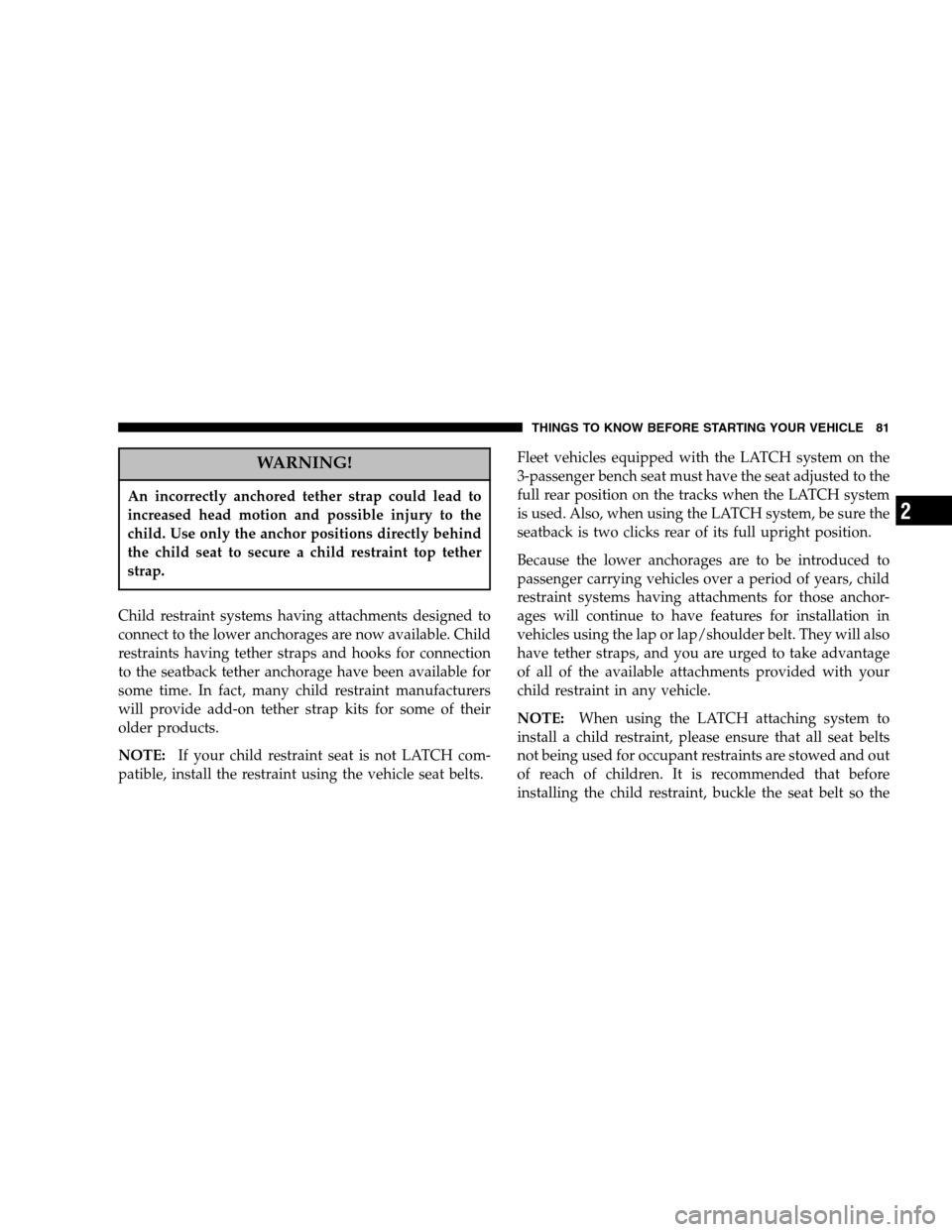
WARNING!
An incorrectly anchored tether strap could lead to
increased head motion and possible injury to the
child. Use only the anchor positions directly behind
the child seat to secure a child restraint top tether
strap.
Child restraint systems having attachments designed to
connect to the lower anchorages are now available. Child
restraints having tether straps and hooks for connection
to the seatback tether anchorage have been available for
some time. In fact, many child restraint manufacturers
will provide add-on tether strap kits for some of their
older products.
NOTE: If your child restraint seat is not LATCH com-
patible, install the restraint using the vehicle seat belts. Fleet vehicles equipped with the LATCH system on the
3-passenger bench seat must have the seat adjusted to the
full rear position on the tracks when the LATCH system
is used. Also, when using the LATCH system, be sure the
seatback is two clicks rear of its full upright position.
Because the lower anchorages are to be introduced to
passenger carrying vehicles over a period of years, child
restraint systems having attachments for those anchor-
ages will continue to have features for installation in
vehicles using the lap or lap/shoulder belt. They will also
have tether straps, and you are urged to take advantage
of all of the available attachments provided with your
child restraint in any vehicle.
NOTE:
When using the LATCH attaching system to
install a child restraint, please ensure that all seat belts
not being used for occupant restraints are stowed and out
of reach of children. It is recommended that before
installing the child restraint, buckle the seat belt so the
THINGS TO KNOW BEFORE STARTING YOUR VEHICLE 81
2
Page 83 of 520
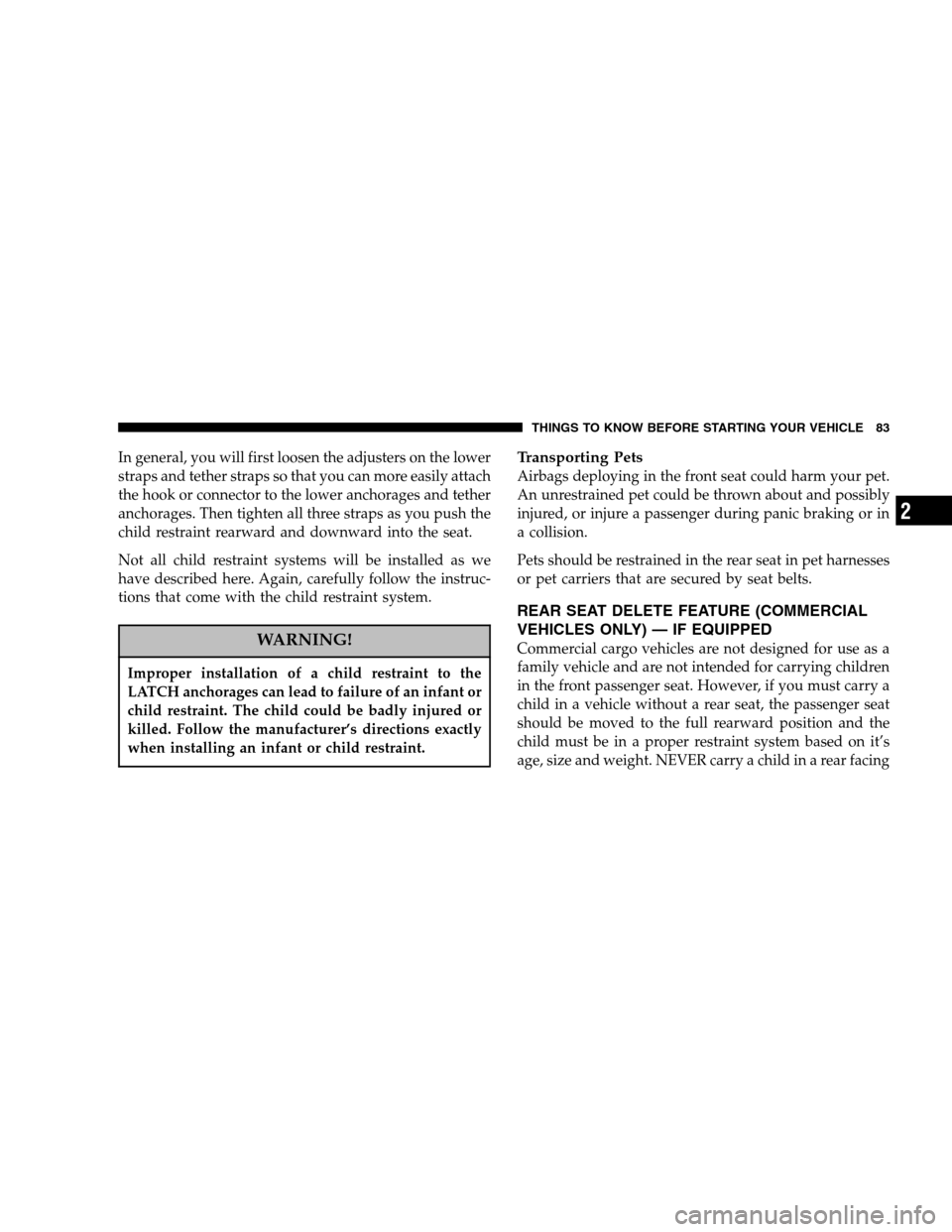
In general, you will first loosen the adjusters on the lower
straps and tether straps so that you can more easily attach
the hook or connector to the lower anchorages and tether
anchorages. Then tighten all three straps as you push the
child restraint rearward and downward into the seat.
Not all child restraint systems will be installed as we
have described here. Again, carefully follow the instruc-
tions that come with the child restraint system.
WARNING!
Improper installation of a child restraint to the
LATCH anchorages can lead to failure of an infant or
child restraint. The child could be badly injured or
killed. Follow the manufacturer’s directions exactly
when installing an infant or child restraint.
Transporting Pets
Airbags deploying in the front seat could harm your pet.
An unrestrained pet could be thrown about and possibly
injured, or injure a passenger during panic braking or in
a collision.
Pets should be restrained in the rear seat in pet harnesses
or pet carriers that are secured by seat belts.
REAR SEAT DELETE FEATURE (COMMERCIAL
VEHICLES ONLY) — IF EQUIPPED
Commercial cargo vehicles are not designed for use as a
family vehicle and are not intended for carrying children
in the front passenger seat. However, if you must carry a
child in a vehicle without a rear seat, the passenger seat
should be moved to the full rearward position and the
child must be in a proper restraint system based on it’s
age, size and weight. NEVER carry a child in a rear facing
THINGS TO KNOW BEFORE STARTING YOUR VEHICLE 83
2
Page 84 of 520
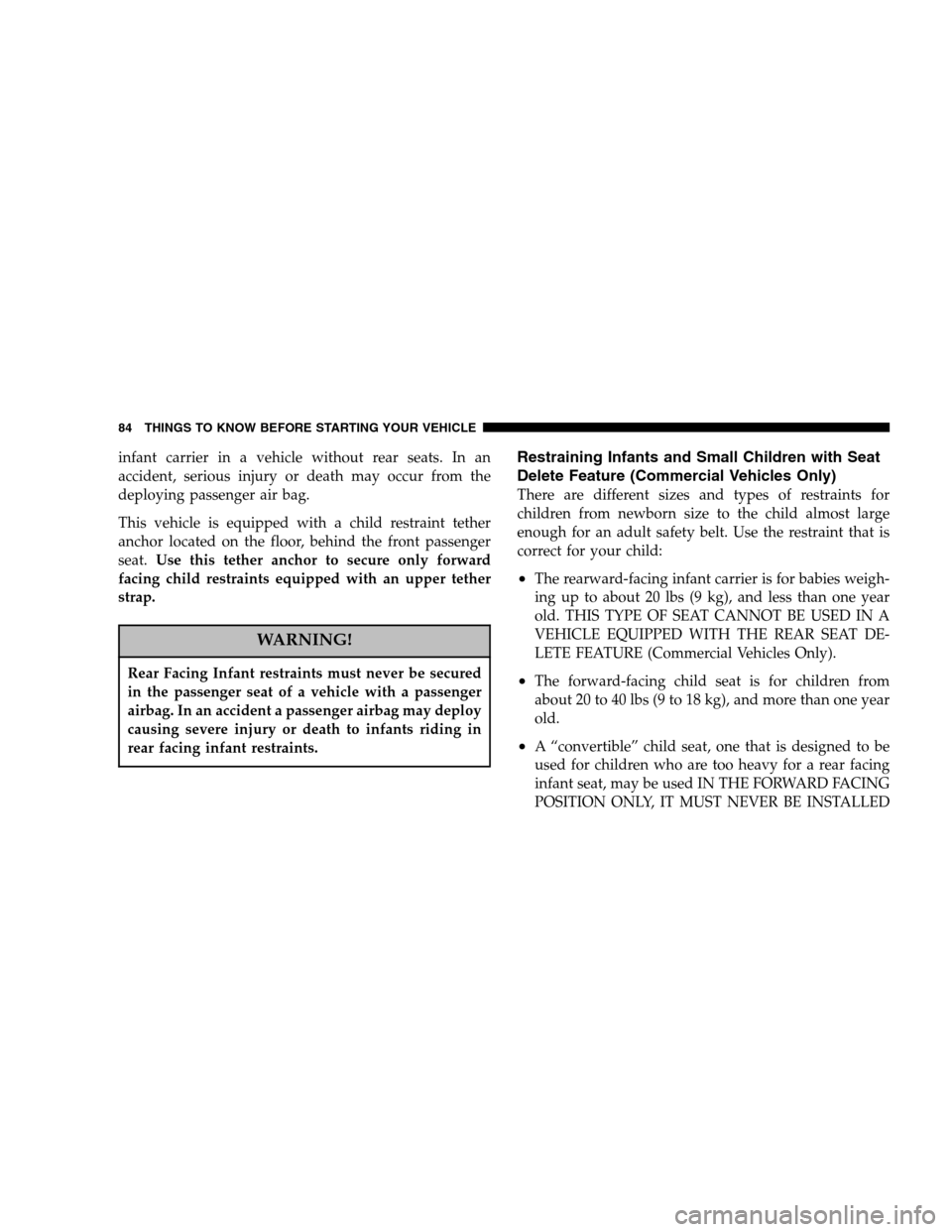
infant carrier in a vehicle without rear seats. In an
accident, serious injury or death may occur from the
deploying passenger air bag.
This vehicle is equipped with a child restraint tether
anchor located on the floor, behind the front passenger
seat. Use this tether anchor to secure only forward
facing child restraints equipped with an upper tether
strap.
WARNING!
Rear Facing Infant restraints must never be secured
in the passenger seat of a vehicle with a passenger
airbag. In an accident a passenger airbag may deploy
causing severe injury or death to infants riding in
rear facing infant restraints.
Restraining Infants and Small Children with Seat
Delete Feature (Commercial Vehicles Only)
There are different sizes and types of restraints for
children from newborn size to the child almost large
enough for an adult safety belt. Use the restraint that is
correct for your child:
•The rearward-facing infant carrier is for babies weigh-
ing up to about 20 lbs (9 kg), and less than one year
old. THIS TYPE OF SEAT CANNOT BE USED IN A
VEHICLE EQUIPPED WITH THE REAR SEAT DE-
LETE FEATURE (Commercial Vehicles Only).
•The forward-facing child seat is for children from
about 20 to 40 lbs (9 to 18 kg), and more than one year
old.
•A “convertible” child seat, one that is designed to be
used for children who are too heavy for a rear facing
infant seat, may be used IN THE FORWARD FACING
POSITION ONLY, IT MUST NEVER BE INSTALLED
84 THINGS TO KNOW BEFORE STARTING YOUR VEHICLE